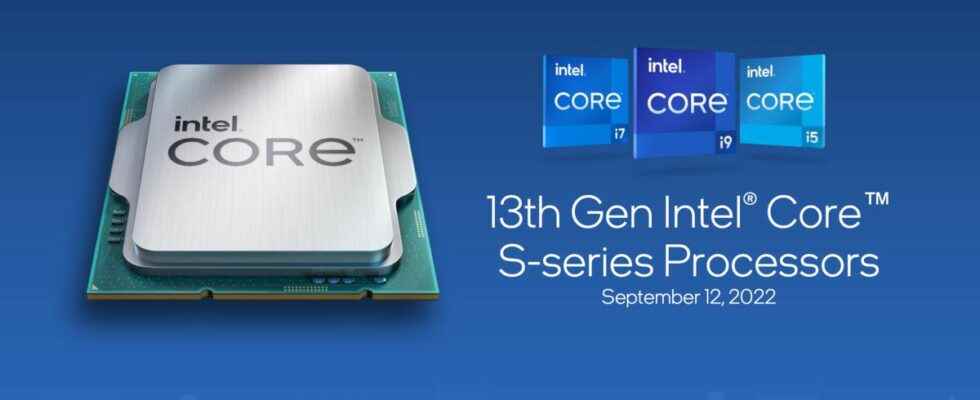After introducing its hybrid architecture with the 12th generation “Alder Lake” Cores, Intel is optimizing it with the 13th generation called Raptor Lake. All this while waiting for a brand new architecture, called Meteor Lake, for the 14th generation of Core scheduled for 2024. Intel makes no secret of it: Raptor Lake is a transition generation, designed in record time to make the junction between Alder Lake and Meteor Lake. This wave of new processors therefore makes it possible to correct the defects of youth and optimize everything that can be.
Doubled E-Cores and Frequency Boost
Raptor Lake doubles the E-Cores and increases its frequencies. © Intel
From the outset, Intel announces gains of 15% in single-core and 41% in multi-core. To obtain such results, the founder played on several parameters: the frequency of the P-Cores has increased significantly, going from 5.2 GHz to 5.8 GHz on the Core i9 and the number of E-Cores has been doubled . The Core i9 thus goes from 8 to 16 E-cores for a total of 32 threads instead of 24.
The P-core change allows for significant gains in frequency. © Intel
Obviously, Intel didn’t just double the number of E-Cores or increase the frequency of P-Cores. These use Raptor Cove cores instead of the Golden Coves used on Alder Lake. The Intel 7 (10 nm) engraving has been improved allowing the Raptor Cove to take 200 Mhz more for the same voltage or to reduce its voltage by 50 mV compared to Golden Cove cores. Intel took the opportunity to add 2 MB of L2 cache to each of the P-cores. Put together, all these improvements allow a gain of 15% in single-core.
The Raptor Lakes see the number of E-Cores double. © Intel
The E-cores are still the same Gracemont cores used on Alder Lake, however they benefit from higher frequencies which can reach 4.3 GHz in turbo, but above all, their number is now doubled, which makes it possible to process more information simultaneously.
Same platform and DDR5 5600
On the side of the platform, nothing or almost nothing changes. Thus, the Raptor Lakes always use the LGA1700 socket and manage 16 PCIe 5x lines and 4 PCIe 4x lines. The only new feature is support for DDR5 5600. Note that DDR4 3200 memory is still supported. This allows Intel to announce double compatibility: motherboards equipped with the Intel Z690 chipset are compatible with 13th gen Intel processors and Intel Z790 motherboards, which accompany the release of 13th gen Core processors, are also compatible with 12th Gen Intel Core processors.
Little change on the platform except support for DDR5 5600. © Intel
Six processors, more later
As with the 12th generation of processors, Intel is only announcing six Raptor Lake references. These are actually three references available in K (with iGPU) and KF (without iGPU) versions. The Intel HD 770 is responsible for playing the role of iGPU. It is therefore the same graphic part used on Alder Lake based on the Xe architecture. We will have to wait for the 14th generation Meteor Lake processors for an overhaul of the integrated graphics part.
The Core i9-13900K and i9-13900KF hold the upper hand. They carry 8 P-Cores (16 threads) and 16 E-Cores (16 threads). They are followed by the Core i7-13700K and i7-13700KF with 8 P-Cores (16 threads) and 8 E-Cores (8 threads). And finally, the Core i5-13600K and i5-13600KF equipped with 6 P-Cores (12 threads) and 8 E-Cores (8 threads).
As for Alder Lake, 6 references to start. © Intel
The frequencies of the P-cores are between 5.8 GHz and 5.1 GHz, the E-cores have a range between 3.9 GHz and 4.3 GHz. In addition to the Turbo Boost Max 3.0 technology, which allows frequencies to be increased depending on the temperature, the Core i9s benefit from the Thermal Velocity Boost technology present on the 11th generation Cores which makes it possible to reach 5.8 GHz when the temperature is below 70°C.
Asked about a possible Raptor Lake operating at 6 GHz seen in Israel during the Intel Tech Tour, the manufacturer leaves the possibility of releasing such a processor in the future, but nothing has been confirmed.
The power consumption of the Raptor Lake is on the rise and more particularly on the Core i7. Thus the TDP is still 125 W for the whole, but the MTP (Maximum Turbo Power) which corresponds to the maximum power drawn by the processor increases. Thus the Core i9 sees its MTP go from 241 to 253 W, the Core i7 goes from 190 to 253 W and the Core i5 from 150 to 181 W. The 13th gen Core i7s being 12th gen Core i9s in terms of the number of hearts and threadsthis is not surprising.
Unchanged pricing, Ryzen 7000 in sight
As for 12th generation processors, Intel does not communicate on prices in euros, but on prices in dollars and therefore excluding taxes. The good news, if we can say so, remains that the prices are strictly identical to those displayed at the launch of the 12th generation, ranging from $264 to $589.
In-game payouts of up to 24%. © Intel
We are now looking forward to receiving the first copies of tests to verify Intel’s allegations with announced gains of 15% in single-core and 41% in multi-core. On the gaming side and on a panel of selected games, the founder announces up to 24% gain compared to the previous generation.
Allegations that we will not fail to verify. © Intel
You will now have to wait until October 20 before you can buy the 13th generation Core from your retailer and find out the real prices in euros.

